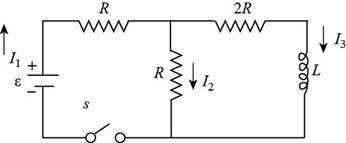
Concept explainers
(a)
The current in inductor.
(a)
Answer to Problem 15P
Explanation of Solution
Given info: value of resistance
Explanation:
Diagram for the circuit connected with a battery, inductor is given below.

Figure (1)
Formula to calculate current in a loop as per Kirchhoff law is,
Here,
Write the expression for net voltage in loop 1,
Write the expression to calculate net voltage in loop 2,
Here,
Substitute
Substitute
Arrange the terms of above equation to simplify for integration.
On integrate,
Let
Differentiate above equation.
Substitute
Substitute
Apply boundary condition,
Substitute
Substitute
Further solve the above expression.
Substitute
Thus, the current in inductor in the terms of time is
Conclusion:
Therefore, current in inductor in the terms of time is
(b)
The current in the switch as a function of time.
(b)
Answer to Problem 15P
Explanation of Solution
From equation (7), the formula to calculate current in inductor is,
From equation (4), the formula to calculate current in switch is,
Substitute
Substitute
Thus, the current in switch is
Conclusion:
Therefore, the current in switch is
Want to see more full solutions like this?
Chapter 31 Solutions
Physics for Scientists and Engineers
- Can someone help me with this question. Thanks.arrow_forwardIdentical rays of light enter three transparent blocks composed of different materials. Light slows down upon entering the blocks.arrow_forwardFor single-slit diffraction, calculate the first three values of (the total phase difference between rays from each edge of the slit) that produce subsidiary maxima by a) using the phasor model, b) setting dr = 0, where I is given by, I = Io (sin (10) ². 2arrow_forward
 Principles of Physics: A Calculus-Based TextPhysicsISBN:9781133104261Author:Raymond A. Serway, John W. JewettPublisher:Cengage Learning
Principles of Physics: A Calculus-Based TextPhysicsISBN:9781133104261Author:Raymond A. Serway, John W. JewettPublisher:Cengage Learning Physics for Scientists and EngineersPhysicsISBN:9781337553278Author:Raymond A. Serway, John W. JewettPublisher:Cengage Learning
Physics for Scientists and EngineersPhysicsISBN:9781337553278Author:Raymond A. Serway, John W. JewettPublisher:Cengage Learning Physics for Scientists and Engineers with Modern ...PhysicsISBN:9781337553292Author:Raymond A. Serway, John W. JewettPublisher:Cengage Learning
Physics for Scientists and Engineers with Modern ...PhysicsISBN:9781337553292Author:Raymond A. Serway, John W. JewettPublisher:Cengage Learning Physics for Scientists and Engineers: Foundations...PhysicsISBN:9781133939146Author:Katz, Debora M.Publisher:Cengage Learning
Physics for Scientists and Engineers: Foundations...PhysicsISBN:9781133939146Author:Katz, Debora M.Publisher:Cengage Learning Physics for Scientists and Engineers, Technology ...PhysicsISBN:9781305116399Author:Raymond A. Serway, John W. JewettPublisher:Cengage Learning
Physics for Scientists and Engineers, Technology ...PhysicsISBN:9781305116399Author:Raymond A. Serway, John W. JewettPublisher:Cengage Learning





